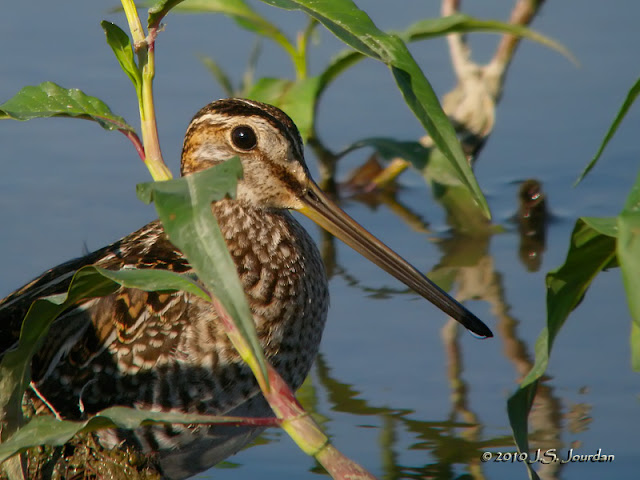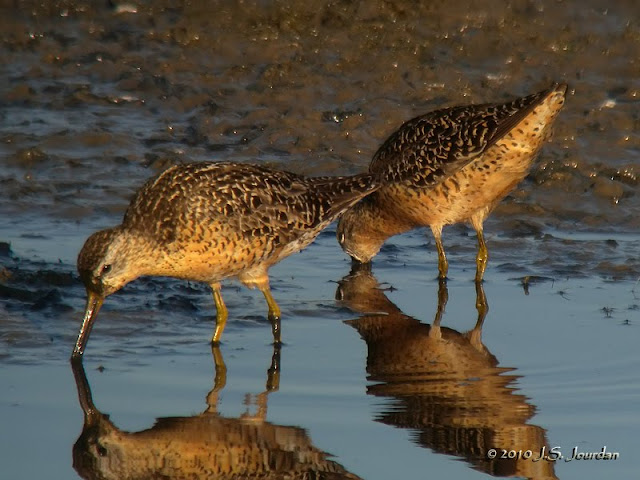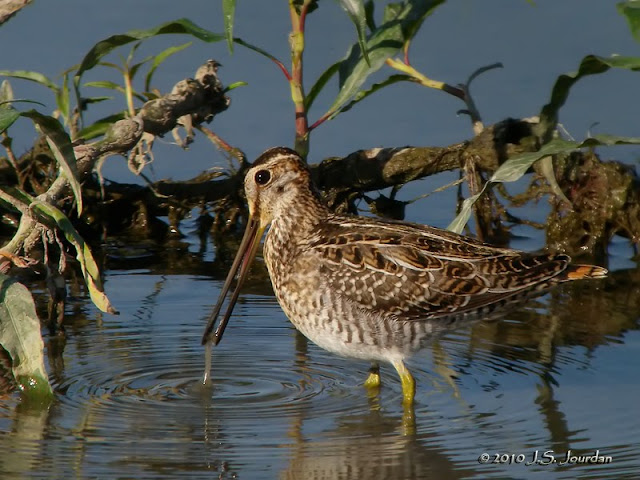Elusive Birds Up Close! - 07 Aug 2010
With the sun rising to my back I was able to catch the first rays as they hit the shoreline to my right. As I rode along the North Causeway I found numerous Lesser Yellowlegs and the occasional Short-billed Dowitcher. A few of the Lessery Yellowlegs were cooperative, allowing some digiscoped images while they foraged along the steep shoreline.
As I headed south along the dike separating Vermet Unit and Long Pond Unit I came upon the first of many Least Sandpipers, Semipalmated Sandpipers, and Pectoral Sandpipers. Whitetailed Deer (doe and fawn) were frozen in the morning sunlight and stayed long enough for a few images with the D300 and Sigma 400mm.
As I continued on I came upon a large flock of shorebirds preening, foraging and fighting. Among the aforementioned were a pair of Black-bellied Plovers and a few more Short-billed Dowitchers.
As they moved away I turned my attention on a pair of fighting Semipalmated Plovers. Two birds continuously chattered at each other, puffed up, squared off and began chest-bumping each other. I took a few digiscoped images from across the ditch, but decided a video would better catch the action. I let the memory card run out and changed cards. 1st gigabyte down and it was still only 7 am.
I then moved forward and found a pair of Short-billed Dowitchers feeding in a mud puddle, and took the opportunity to catch some diagnostic images. The Black-bellied Plovers were nearby, so I again took the opportunity to catch a few more digiscoped images from about 50' away.
As I was about to head out I noticed a long-billed shorebird directly across the ditch from me and sunning itself at the water's edge. Wilson's Snipe!
Not only have I not seen one so far from heavy cover, but this little guy was literally just a few feet away from me. And next to it was another snipe. I slowly turned the scope toward them and got glorious views of them as they posed and acknowledged passing peeps. I digiscoped as fast as I could, knowing that this would be another opportunity not soon to be repeated. I had a bit of a time getting them through the phragmites, but some generous cropping helped to remove the annoying geen and brown streaks through several images. Gorgeous feathering on these little gems. They soon flew off, circling around me a couple of times, then disappeared into the Vermet Unit.
Satisfied, I then noticed that Scott Jennex and Mary Trombley were at the junction of the Long Pond, Vermet and Lead Units, so I caught up them and convinced them to head toward Cell 3 of the Banana Unit. We stopped long enough to check the Ospreys (3) on the platform in the Lead Unit, and to enjoy the sunflowers straining in the direction of the morning sun.
Cell 3 was hopping with shorebirds and gulls, and we quickly set to work looking for the Marbled Godwit seen yesterday. It had not been relocated since I reported it early in the morning, so perhaps it had moved on.
As I scanned the Semipalmated Sandpipers and Least Sandpipers along the north shoreline below me I spotted yet another Wilson's Snipe. This little guy was also just a few feet away and in perfect lighting. I emptied my second card digiscoping it, and got some wonderful portrait shots before it hunkered down in a small patch of weeds.
I then decided to grab a few pics w/ the D300, and the sound of the shutter clicks spooked it and the semipalms just enough to flush and fly a few feet away. This provided a wonderful opportunity to capture the White-rumped Sandpiper in flight and get its diagnostic white rump feathers in flight. A Semipalmated Sandpiper flying alongside also provided a perfect comparison for size and tail feathering. Awesome!
Tracking them helped me notice a Common Snapping Turtle that was in the middle of the trail. I almost ran over it, but managed to avoid it. I quickly got off the bike and headed back to get some pics of it as it lay in the road. After picking up the turtle carefully I hopped back on the bike with the plan to relocate it to water and safety.
Exceptional birding day! And I got to photographs some birds that have given me fits for years.
Pte. Mouillee SGA (permit required Sep 1-Dec 15), Monroe, Michigan, US
Aug 7, 2010 6:30 AM - 9:30 AM
Protocol: Traveling
8.0 mile(s)
Checklist Comments: Clear, sunny, warm
15 species
Black-bellied Plover (Pluvialis squatarola) 2
Semipalmated Plover (Charadrius semipalmatus) 2
Short-billed Dowitcher (Limnodromus griseus) 11
Wilson's Snipe (Gallinago delicata) 3
Solitary Sandpiper (Tringa solitaria) 1
Lesser Yellowlegs (Tringa flavipes) 6
Stilt Sandpiper (Calidris himantopus) 3
White-rumped Sandpiper (Calidris fuscicollis) 1
Least Sandpiper (Calidris minutilla) 18
Pectoral Sandpiper (Calidris melanotos) 14
Semipalmated Sandpiper (Calidris pusilla) 42
Ring-billed Gull (Larus delawarensis) 36
Herring Gull (Larus argentatus) 10
Osprey (Pandion haliaetus) 3 2 adults and 1 young
Purple Martin (Progne subis) 150
View this checklist online at https://ebird.org/checklist/S1
This report was generated automatically by eBird v3 (https://ebird.org/home)
Aug 7, 2010 6:30 AM - 9:30 AM
Protocol: Traveling
8.0 mile(s)
Checklist Comments: Clear, sunny, warm
15 species
Black-bellied Plover (Pluvialis squatarola) 2
Semipalmated Plover (Charadrius semipalmatus) 2
Short-billed Dowitcher (Limnodromus griseus) 11
Wilson's Snipe (Gallinago delicata) 3
Solitary Sandpiper (Tringa solitaria) 1
Lesser Yellowlegs (Tringa flavipes) 6
Stilt Sandpiper (Calidris himantopus) 3
White-rumped Sandpiper (Calidris fuscicollis) 1
Least Sandpiper (Calidris minutilla) 18
Pectoral Sandpiper (Calidris melanotos) 14
Semipalmated Sandpiper (Calidris pusilla) 42
Ring-billed Gull (Larus delawarensis) 36
Herring Gull (Larus argentatus) 10
Osprey (Pandion haliaetus) 3 2 adults and 1 young
Purple Martin (Progne subis) 150
View this checklist online at https://ebird.org/checklist/S1
This report was generated automatically by eBird v3 (https://ebird.org/home)

















































Great assortment Jerry you have some great Digiscoping
ReplyDelete